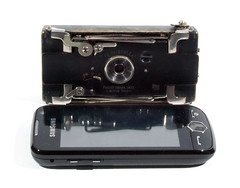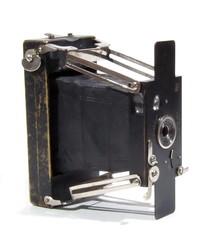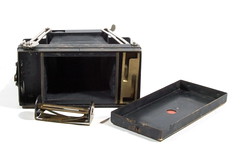Ensignette
The Ensignette was one of the very characteristic camera types of Houghtons Ltd., London. This strut folding rollfilm camera of Houghton's "Ensign – British made" brand was an ingenious construction, a real vest pocket item when folded. One of the round framed impressions on its front plate says that it was based on patent 28464 of the year 1907. The Swedish engineer Magnus Niéll had designed this first British all-metal camera of which ten of thousands were made. The camera was launched before Christmas 1909. It was ordered by distributors all over the world, for example by G. Gennert.
The Ensignette was a milestone in popular photography, providing for the first time a practical, truly compact camera at an affordable price to the average man. It was immensely popular, its appearance being timed perfectly to fill the need for a compact pocketable camera. It helped create a new type of photographer the 'Pocket Snap Shooter'.
The camera was designed like a luxurious cigarette metal case, with parts made of different kinds of brass and other metals, except some interior parts and the bellows which was made of very thin leather. Some metal parts were plated. The common feature being the use of struts on all Ensignette cameras. [1]
Contents
Ensignette No.1
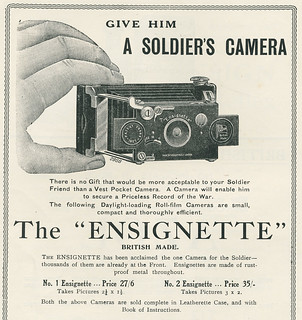
|
| 1916 advertisement scanned by Geoff Harrisson (Image rights) |
The front plate end tabs of the early model No.1 are plain. From around 1911 an embossed flag logo is added to the right-hand tab and patent details to the left-hand tab. Aluminium body from 1920 is identifiable by embossed oval shapes at ends of front plate. Pre-1911 cameras have a flat front plate with the "N-sign" trademark engraved on the bottom corner. Post-1911 cameras have embossed circles on both ends of the front plate where the narrower extensions begin.
Ensignette No.1 principal models
- No.1: Introduced in 1909.
- No.1 presentation model: same as original model, nickel plated finish with red bellows and embossed end tabs of the front plate, uncommon, c.1912, (there was a very expensive silver plated model also)
- No.1 model 1z: with f/6.8, 7.5 cm Zeiss Tessar lens, aperture stops f6.8, f11, f22. with direct-vision optical viewfinder (1911-15)
- No.1 1915 version: this version is very similar to the original No.1. It has the improved shutter introduced around 1915 and aperture setting via a ring surrounding the lens, with embossed front plate end tabs.
- No.1 focusing anastigmat model: nickel plated, black bellows, various anastigmat lenses, focussing wheel and the scale at the bottom of the front plate, uncommon, c.1912
- No.1 anastigmat: brass body, Cooke Anastigmat f/5.6, Aldis, Goerz Syntor f/6.8, "Ensign" Anastigmat f/5.6 or Zeiss Tessar focusing lenses, focusing wheel and the scale at the bottom of the front plate, c.1910
- No.1 anastigmat aluminium: oval shaped embossings on front plate tabs, aluminium body, c.1920
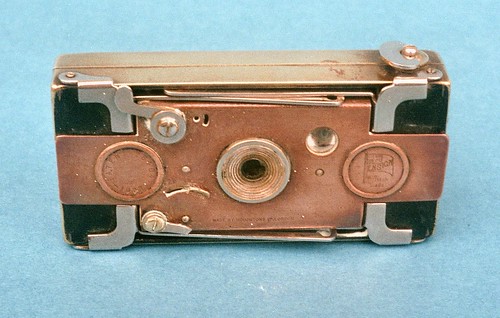
|
| Ensignette No.1 a post-1911 version image by Uwe Kulick (Image rights) |
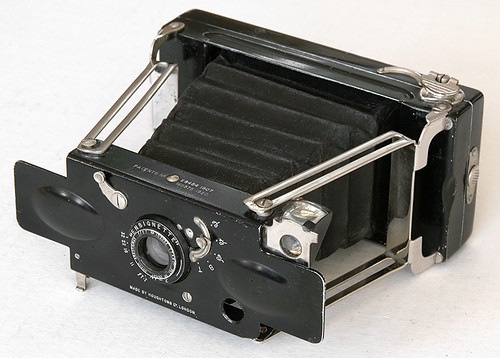
|
| No.1 Aluminium Ensignette image by Geoff Harrisson (Image rights) |
Ensignette No.1 original early model specifications
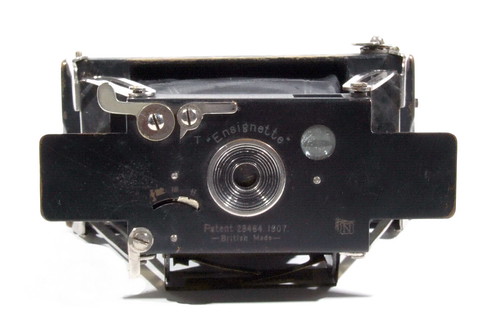
|
| Ensignette No.1 very early model (1909) image by Süleyman Demir (Image rights) |
- Film: Ensign E1 size roll-film
- Picture size: 1 1/2 x 2 1/4 inches (3.8 x 5.7 cm ), 6 exposures
- Ensign E1 film was introduced in 1909. Eastman Kodak produced no.128 film for this camera in 1913.
- Engravings on the front plate: Ensignette, Patent 28464 1907, British Made, and at the bottom corner "N-sign" trademark (the early Ensign logo).
- Lens: simple achromatic meniscus lens f/11 (standard lens), behind the shutter
- Aperture: f/11 - f/8- f/22. Three different round aperture masks were selectable by a small lever and scale on the right of the front plate
- Focusing: fixed focus, minimum distance 12 feet
- Shutter: everset, pivoted two-blade return, speeds: instant 1/40 (?) + T.
- Setting: T via a lever beside the shutter release lever
- Cocking lever and shutter release: same lever, on the front plate, for instant press and release
- Viewfinder: waist level Brilliant finder for landscape only, mounted into the front standard
- Bellows: thin leather
- Front plate: end tabs are plain
- Front plate and bellows opening: pull out the front plate using the end tabs until the struts clicks to it; closing: simply release the struts from the front plate and pull in
- Extensions on each side of the front plate serve as table stands also
- Film winding: by a small lever on top of the camera
- Folding leg on the bottom of the front plate
- Back cover: removable, opens by a latch on the left side of the camera, with a red window w/ a lid
- Film loading: by very special spools mechanism
- Body: black painted brass made with nickel-plated fittings; Weight: 220g
- Serial no. behind the back cover
|
|
| ||||||
| Ensignette No.1 very early model (1909)
Images by Süleyman Demir (Image rights) | ||||||||
Ensignette No.2
Ensignette No.2 principal models
- No.2
- Introduced in 1912.
- Film: Ensign E2 roll-film, 2" x 3", six exposures
- Eastman Kodak produced No.129 film for this camera in 1913
- Body brass
- Achromatic meniscus lens
- Flat front plate with pressed circles either side tabs, Ensign flag logo saying British made, and on the left side has "Made by Houghton's Ltd. England"
- No.2 presentation model: nickel plated finish with red bellows. c.1911 (there was a very higher- value silver plated finish also)
- No.2 gilt finish: very rare variation with green bellows c.1912
- Anastigmat No.2 (Ensignette De-Luxe): a model of original No.2 with a higher quality shutter
- No.2 B anastigmat: Cooke anastigmat f/6.8 lens, focusing lever above the front plate, uncommon early focusing version, c.1912
- No.2 C De Luxe: various lenses, focusing lever on the right side of the front panel, c.1913
- No.2 Z De Luxe: brass body with focusing Zeiss Tessar f/6.3 in Compound shutter, rare, c.1913
- No.2 aluminium: c.1920
- No.2 aluminium De Luxe: c.1920
Other models
- Vest Pocket Ensignette
- Introduced in 1923
- Similar to the model 2 but uses for 1 5/8" x 2 1/2" frames on No.1J (127) roll-film and
- Three years later production of the other sizes ceased, the Vest Pocket model lasted a few more years
- Eastman Kodak introduced the standard No.127 size roll-film in 1923
- Ensignette Junior (1913)
- Popular Ensignette (1922)
- These two were strut type roll-film cameras for 2 ¼" x 3 ¼" exposures but do not resemble the smaller models
Notes
- ↑ McKeown, James M. and Joan C. McKeown's Price Guide to Antique and Classic Cameras, 12th Edition, 2005-2006. USA, Centennial Photo Service, 2004. ISBN 0-931838-40-1 (hardcover). ISBN 0-931838-41-X (softcover). p.403
